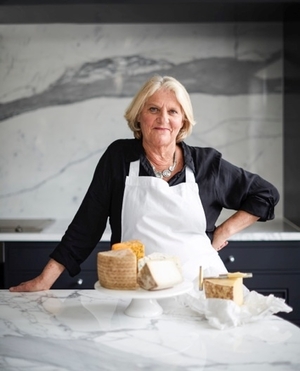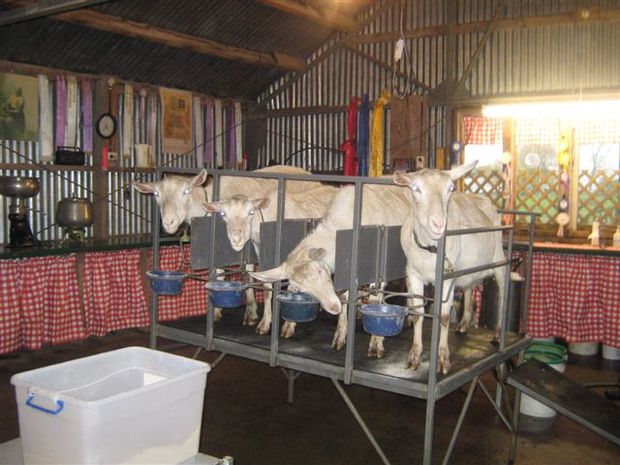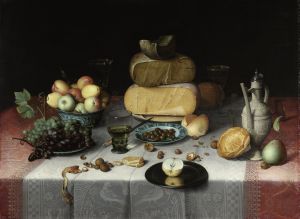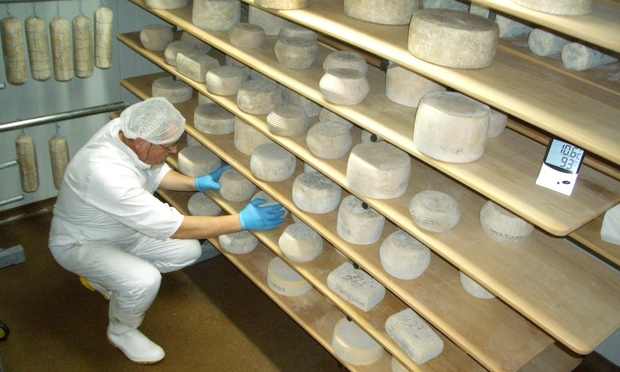More about cheese
Paneer with Julie Biuso
Julie has got a delicious dish of fried paneer with a spicy tomato topping. She will also cover off making paneer which is pretty easy and great for dishes like Mattar Paneer.
World cheese authority Juliet Harbutt
 Juliet Harbutt – an authority on the history, cheesemaking styles and characteristics of the great cheeses of the world – loves to pass her knowledge on to others.
Juliet Harbutt – an authority on the history, cheesemaking styles and characteristics of the great cheeses of the world – loves to pass her knowledge on to others.
The ex-pat New Zealander, who has lived in the UK for 30 years and set up a very successful cheese shop in London, is currently here running a series of cheese tastings and classes through the School of Food and Wine in Auckland.
She has told Kathryn Ryan there are seven types of cheeses and a good cheeseboard should include around five, from different categories, shapes, textures, flavours and intensities.
Find out more about cheese on Radio Zealand.
Juliet Harbutt's Seven Categories Of Cheese
The character of a cheese can usually be judged by a glance at its cover or rind and an occasional squeeze. From this brief encounter you can learn to judge its texture, strength of flavour, basic character and, with a little practice, its maturity. Using the "rind'' method, you can categorise 99 per cent of all cheeses into one of the following.
Fresh Cheeses [no rind]
Examples: cream cheese, ricotta, feta, mozzarella
Only 1-15 days old without time to develop a rind and only a subtle "lactic'', fermenting fruit flavour with a hint of the green pastures. Often wrapped in chestnut leaves, rolled in ash or covered in herbs.
Aged Fresh Cheeses [grey-blue with wrinkly rinds]
Examples: chevrolait from Crescent Dairy and imported from the Loire Valley, from goat's milk: Crottin de Chavignol, pyramid, chabicou, coeur du Berry
Some fresh cheeses are left to drain and dry out gradually, developing a bluish-grey mould, a wrinkled rind and more pronounced flavour. These are most typically found in France and usually made with goat's milk.
Soft White [white fuzzy rind]
Examples: Camembert, Capricorn goat
The curd retains much of the whey, ensuring the cheese becomes soft and creamy and grows a white mould, penicillin candidum. Unpasteurised varieties develop a reddish-brown ferment on the rind whereas pasteurised versions are more 'Persil' white in appearance. Those made by adding cream to the milk are outrageously luxurious in taste and texture, such as explorateur, brillat savarin.
Semi-Soft [brown-orange to grey-brown]
Examples: Edam, Pont l'Eveque, young Gouda, Colby, Egmont
The moist curd is placed in moulds and lightly pressed to speed up draining. Various moulds develop, which are regularly brushed off building up a thickish rind, protecting the cheese and allowing it to mature. Some are "washed' creating an orange/ pink rind with a strong, piquant flavour and aroma, like langres, stinking bishop, epoisses and dirty devil.
Hard [thick, dense rind often waxed or oiled]
Examples: cheddar, Wensleydale, parmigiano reggiano
The curd is cut finely, then heated in vats before the whey is drained off. The curd is cut again or even "milled'' and piled on top of itself to remove even more of the whey - this process is called cheddaring. The curd is salted, packed in moulds lined with cheesecloth and firmly pressed.
Blue [gritty, rough, dry or sticky]
Examples: Stilton, Roquefort, Gorgonzola
The blue moulds, P. glaucum or P. Roqueforti are added to the milk but need oxygen to develop their colour. This is achieved by piercing the cheese with rods. The blue then grows along the tunnel, cracks and trails between the roughly packed curd.
Flavour Added [barely formed rind]
Examples: Stilton with apricots, Cornish Yarg, smoked cheddar
Hard cheeses to which ingredients are added to the curd or rubbed into the rind such as nuts, fruit, spices, herbs, hops and nettles; these include smoked cheeses. Blended cheeses are made by breaking up young cheeses, combining them with various sweet or savoury ingredients then re- forming them. A rapidly developing product, these offer an alternative for those who like dessert or who are not sure they like cheese
Artisan Cheese Production

Artisan cheese makers in New Zealand toe a tough line. Aside from the vagaries of small business, the cost of complying with stringent regulations proves formidable for many producers. What do these regulations involve? And is artisan cheese making a viable venture in NZ?
According to Biddy Fraser Davies of Cwmglyn Cheese in Eketahuna who has a milking herd of four, the costs associated with producing cheese in her tiny one person cheese room beside the milking shed are the same as if she were producing 50 times as much cheese. When she started making cheese eleven years ago, she got a licence for $100 from the local council. Now her costs run to about at least 25% of her turnover. And although she and husband Colin don’t have a mortgage and receive a pension, they still find it difficult to make a profit.
John and Jeanne van Kuyk of Aroha Organic Goat Cheese in Te Aroha are also retired, and they have a small flock of Saanen and Anglo-Nubians goats. Their compliance costs are substantially higher as they also make unpasteurized cheese – the first company in New Zealand to be certified by MPI to make raw milk cheese for commercial purposes. They charge what it costs to make the cheese – approximately $5.45/100 grams for their pasteurized cheese and $12.25/100 grams – two and a quarter times as much. They must test the milk, the curd and the final cheese for every single batch. And they have three audits a year as well. But they don’t produce cheese for profit – they simply love the lifestyle.
Further north, Annie and Phil Armstrong run one of two milking buffalo herds in New Zealand: Whangaripo. They say testing all their cheeses is a huge expense and it eats into their profit margin. They make both hard and soft cheese and the soft cheese requires a greater degree of testing. They’d like to make raw cheese and get organic certification, but the expenditure is too daunting. Of the three producers, they all agree on one thing: they don’t think the regulations are too strict, and they want to keep their customers safe – they just think it costs too much for the size of their businesses.
We approached MPI for comment, but no one was available to speak to us. Instead they provided this written statement addressing some of our questions:
New Zealand prides itself as a producer of safe, high quality food – sold here and overseas. Milking animals and making cheese carry risks that need to be managed carefully in order for products to be safe for people to consume. Even one ‘bad batch’ that causes illness can have far-reaching consequences for other dairy operators’ reputations and for New Zealand’s reputation as a whole.
All food producers in New Zealand must produce food that is safe and suitable, however the requirements the Ministry for Primary Industries (MPI) sets to regulate this are risk-based and vary based on the type of food produced. Higher-risk food industries, such as dairy manufacturing, must meet stricter food safety requirements related to the likely hazards, processing complexity and the products produced, regardless of the size of the business.
All food for sale must meet the requirements of the Food Act. Farm dairies, where the milking takes place, must operate under a risk management programme (RMP) under the Animal Products Act, while cheese makers can opt to register under an RMP under the Animal Products Act or a food safety programme (FSP) under the Food Act – provided they are only selling the product in New Zealand and Australia. These management programmes outline the measures a business will take to ensure they are meeting their food safety requirements.
To save on costs, cheese makers can choose to register an RMP for both parts of their operation (ie farm dairy and cheese making). This means one verifier can check that the business is meeting their necessary food safety requirements during one visit, which means businesses are not paying for separate verification costs.
Both programme options take a risk-based approach to food safety and require the business to choose a verifier or auditor that has been approved by MPI to visit and check the programme is working effectively. There are a range of checks and balances in place to ensure any problems are detected and the food produced is safe.
This verification or audit is provided by organisations independent of MPI and the costs are set by these organisations.
MPI also recovers costs associated with providing services to each dairy processor, regardless of how much they produce. This covers important services such as the monitoring of dairy products to ensure consumer safety, systems performance monitoring and management, and the development and maintenance of New Zealand standards.
We are currently consulting on a range of proposals to update the way we recover costs from individuals and industries to provide essential food safety and biosecurity services.
None of these proposals are set in stone and all feedback will help us form good regulations.
We recognise that the level of charges has an impact on businesses and we have worked hard to keep costs down. At the same time, we cannot take short cuts on our food safety system because it provides for the safety of consumers and New Zealand's reputation as a producer of safe food - this consultation is an important part of getting that balance right.
Related Stories
World cheese authority Juliet Harbutt on NZ artisan cheeses
Biddy Fraser Davies on Country Life
Biddy Fraser Davies says audit costs will scupper her business
Formaggio per favore!
Emilio Festa came to New Zealand from northern Italy with a dream of making cheese.
After selling their property the Lombardia region in 2008 , Emilio and his wife Adriana bought a small cropping farm near West Melton in Canterbury and, four years later, built a custom-made cheese factory in the farmyard.
As well as growing barley and lucerne, Emilio makes over 20 types of Italian style cheese and sells it to restaurants and at farmers' markets throughout Canterbury.
"I have to say I have in my blood Italian cheese and for that reason what I would like to do is try offer people here some real taste, real flavours and texture of Italian cheese".
Emilio won the New Zealand Champion of Cheese Award for 2014.

The big cheese
Gisborne based, multi award winning Waimata Cheese has been making hand crafted wheels for 15 years.
Katherine Mowbray: cheesemaking
Craft cheesemaker who has been making cheese for 20 years, and shares her knowledge and love of cheesemaking at courses around New Zealand.
Holy Cheese
Karikaas cheeses are all hand-made using traditional European methods by cheese-makers who are proud of their traditions and skill.
Sherrington Grange
Sherrington Grange recently won the Rural Women Enterprise Award not only for the South Island, but the National award as well. It's a mother and daughter boutique cheese making operation which offers home stays and cheese making courses at Mahau Sound between Picton and Nelson. Fill your pot with milk and find out how to make ricotta cheese.
Cheese-making in the Marlborough Sounds
Lisa Harper recently won the the Supreme Award in the 2011 Enterprising Rural Women Awards. She is involved in the family business, Sherrington Grange, a 180ha farm in the Mahau Sound, with her mother, two brothers and their families.
Bolshy Blue Cheese
As the Head of Food Sciences at the University of Nottingham, Prof. Christine Dodd regularly pares back what we eat to a molecular level, for instance, her latest research has helped to pinpoint the yeast that enhances the smell of certain cheeses.
Lisa Harper - cheese and rural women
Artisan cheesemaker and farmer who has been travelling the world this year on a Nuffield Scholarship, and has just published her memoir, The Wharf at Waterfall Bay.
Aroha Organic Goat Cheese
Amelia Nurse visits Aroha Organic Goat Cheese, who've recently become the first producer in New Zealand to gain MPI approval to produce raw milk cheese.
The Italian cheese men
When Italian travellers Matteo Bordini and Raffaello Sirri met by chance at a picnic in Nelson two years ago, they lamented about how much they missed traditional Italian cheese and joked about making their own. What started out as a joke between two new friends has now become a reality.

Still Life with Cheese, Floris Claesz. van Dijck, c. 1615.
Recipes
